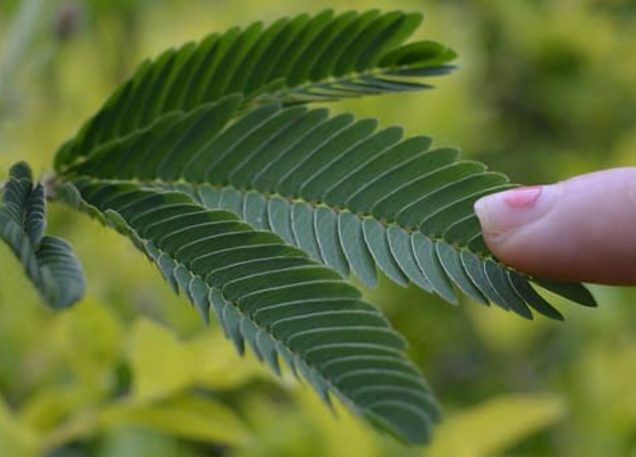
When the leaf of the ‘touch-me-not' (Chui-Mui, Mimosa pudica) plant is touched, the leaf drops because
(a) A nerve signal passes through the plant
(b) The temperature of the plant increases
(c) Water is lost from the cells at the base of the leaf
(d) The plant dies
Answer
567.9k+ views
Hint: Leaves of Mimosa pudica exhibit movements when touched. When touched, this sensitive leaf reacts to stimulus as there is higher pressure at that point. This causes the leaves to close. It is due to the turgor pressure difference between the upper and lower halves of the base of the petiole (pulvinus) . Thus, the entire leaf droops down when touched.
Complete step by step answer:
Leaves of Mimosa pudica are sensitive. When touched the stimulus reaches the base of the leaf and the water in the vacuoles of the cells of the leaf loses water to the adjacent cell. All the water escapes the leaf which then becomes flaccid. This causes the leaves to close. This is due to the passing of impulse which causes the change of turgor pressure. Owing to this stimulus, the turgor of the lower half of the pulvinus is lost and the leaf droops down. Mimosa plants use their ability to shrink as a defense from herbivores. Animals may be afraid of a fast-moving plant and would rather eat a less active one. Also, the sudden movement dislodges harmful insects. They will reopen after a few minutes. The main structure responsible for the drooping of the leaves is the pulvinus. The stimulus is transmitted as an action potential from a stimulated leaflet to the leaflet’s swollen base, and from there to the pulvini of the other leaflets, which run along the length of the leaf’s rachis. The action potential then passes into the petiole, and finally to the large pulvinus at the end of the petiole, where the leaf attaches to the stem.

So, the correct answer is, ‘(c) Water is lost from the cells at the base of the leaf’.
Additional Information:
- Mimosa pudica is a tropical creeping plant. It belongs to the sub-family Mimosaceae.
- They are commonly known as sleeping plants, shy plants, shame plants, touch me not, sensitive plants, action plants, etc.
- The reflex mechanism may have evolved as a defense mechanism to escape from predators or to reduce water loss due to evaporation.
Note:
- The closing of leaflets when stimulated by touching, warming, blowing, shaking, etc. have been termed as seismonastic movements.
- Due to Mimosa’s unique response to touch, it became an ideal plant for many experiments regarding plant habituation and memory.
- Mimosa pudica is used in Ayurveda. They are used to treat leprosy, dysentery, vaginal and uterine complaints, burning sensation, etc.
Complete step by step answer:
Leaves of Mimosa pudica are sensitive. When touched the stimulus reaches the base of the leaf and the water in the vacuoles of the cells of the leaf loses water to the adjacent cell. All the water escapes the leaf which then becomes flaccid. This causes the leaves to close. This is due to the passing of impulse which causes the change of turgor pressure. Owing to this stimulus, the turgor of the lower half of the pulvinus is lost and the leaf droops down. Mimosa plants use their ability to shrink as a defense from herbivores. Animals may be afraid of a fast-moving plant and would rather eat a less active one. Also, the sudden movement dislodges harmful insects. They will reopen after a few minutes. The main structure responsible for the drooping of the leaves is the pulvinus. The stimulus is transmitted as an action potential from a stimulated leaflet to the leaflet’s swollen base, and from there to the pulvini of the other leaflets, which run along the length of the leaf’s rachis. The action potential then passes into the petiole, and finally to the large pulvinus at the end of the petiole, where the leaf attaches to the stem.

So, the correct answer is, ‘(c) Water is lost from the cells at the base of the leaf’.
Additional Information:
- Mimosa pudica is a tropical creeping plant. It belongs to the sub-family Mimosaceae.
- They are commonly known as sleeping plants, shy plants, shame plants, touch me not, sensitive plants, action plants, etc.
- The reflex mechanism may have evolved as a defense mechanism to escape from predators or to reduce water loss due to evaporation.
Note:
- The closing of leaflets when stimulated by touching, warming, blowing, shaking, etc. have been termed as seismonastic movements.
- Due to Mimosa’s unique response to touch, it became an ideal plant for many experiments regarding plant habituation and memory.
- Mimosa pudica is used in Ayurveda. They are used to treat leprosy, dysentery, vaginal and uterine complaints, burning sensation, etc.
Recently Updated Pages
Master Class 11 Business Studies: Engaging Questions & Answers for Success

Master Class 11 Computer Science: Engaging Questions & Answers for Success

Master Class 11 Maths: Engaging Questions & Answers for Success

Master Class 11 Chemistry: Engaging Questions & Answers for Success

Master Class 11 Economics: Engaging Questions & Answers for Success

Master Class 11 Accountancy: Engaging Questions & Answers for Success

Trending doubts
What is meant by exothermic and endothermic reactions class 11 chemistry CBSE

10 examples of friction in our daily life

One Metric ton is equal to kg A 10000 B 1000 C 100 class 11 physics CBSE

1 Quintal is equal to a 110 kg b 10 kg c 100kg d 1000 class 11 physics CBSE

Difference Between Prokaryotic Cells and Eukaryotic Cells

What are Quantum numbers Explain the quantum number class 11 chemistry CBSE




